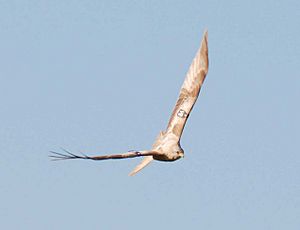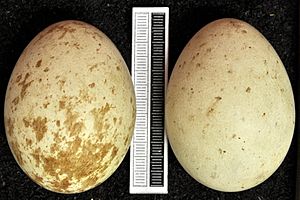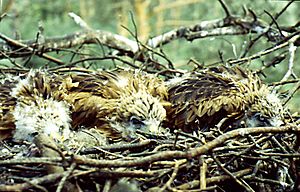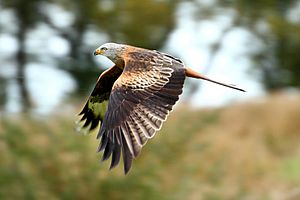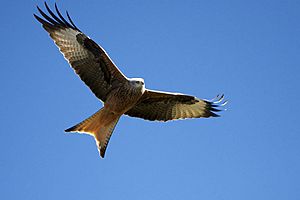Red kite facts for kids
Quick facts for kids Red kite |
|
|---|---|
 |
|
| Red kite in Spain | |
| Conservation status | |
| Scientific classification | |
| Kingdom: | |
| Class: | |
| Order: | |
| Family: | |
| Subfamily: | |
| Genus: |
Milvus
|
| Binomial name | |
| Milvus milvus |
|
The red kite (Milvus milvus) is a medium-large bird of prey in the family Accipitridae. This family also has other raptors such as eagles, buzzards, and harriers.
The species is found all over Europe and northwest Africa. It is resident in the milder parts of its range in western Europe and northwest Africa, but birds from northeastern and central Europe winter further south and west, reaching south to Turkey.
Red kites eat small mammals and carrion. They were wiped out in most of Britain, except for a few in south Wales. Farmers killed them, and so did the DDT picked up from their prey. They have made a big come-back in England and Scotland after they were recently re-introduced.
A sighting of the first red kite in London for 150 years was reported in The Independent newspaper in January 2006. In June 2006, the UK-based Northern Kites Project reported that kites had bred in the Derwent Valley, Tyne and Wear for the first time since the re-introduction.
Contents
Description
Red kites are 60 to 70 cm (24 to 28 in) long with a 175–179 cm (69–70 in) wingspan; males weigh 800–1,200 g (28–42 oz), and females 1,000–1,300 g (35–46 oz). It is an elegant bird, soaring on long wings held at a dihedral, and long forked tail, twisting as it changes direction. The body, upper tail and wing coverts are rufous. The white primary flight feathers contrast with the black wing tips and dark secondaries. Apart from the weight difference, the sexes are similar, but juveniles have a buff breast and belly. Its call is a thin piping sound, similar to but less mewling than the common buzzard. There is a rare white leucistic form accounting for approximately 1% of hatchlings in the Welsh population but is at a disadvantage in the survival stakes.
Differences between adults and juveniles
Adults differ from juveniles in a number of characteristics:
- Adults are overall more deeply rufous, compared with the more washed out colour of juveniles;
- Adults have black breast-streaks whereas on juveniles these are pale;
- Juveniles have a less deeply forked tail, with a dark subterminal band;
- Juveniles have pale tips to all of the greater-coverts (secondary and primary) on both the upper- and under-wings, forming a long narrow pale line; adults have pale fringes to upperwing secondary-coverts only.
These differences hold throughout most of the first year of a bird's life.
Behaviour
Breeding
Usually red kites first breed when they are two years old, although exceptionally they can successfully breed when they are only one year old. They are monogamous and the pair-bond in resident populations is probably maintained during the winter, particularly when the pair remain on their breeding territory. For migrant populations the fidelity to a particular nesting site means that the pair-bond is likely to be renewed each breeding season. The nest is normally placed in a fork of a large hardwood tree at a height of between 12 and 15 m (39 and 49 ft) above the ground. A pair will sometimes use a nest from the previous year and can occasionally occupy an old nest of the common buzzard. The nest is built by both sexes. The male brings dead twigs 30–50 cm (12–20 in) in length which are placed by the female. The nest is lined with grass and sometimes also with sheep's wool. Unlike the black kite, no greenery is added to the nest. Both sexes continue to add material to the nest during the incubation and nestling periods. Nests vary greatly in size and can become large when the same nest is occupied for several seasons.
The eggs are laid at three-day intervals. The clutch is usually between one and three eggs but 4 and even 5 eggs have occasionally been recorded. The eggs are non-glossy with a white ground and red-brown spots. The average size is 57 mm × 45 mm (2.2 in × 1.8 in) with a calculated weight of 63 g (2.2 oz). In Britain and in central Europe laying begins at the end of March but in the Mediterranean area laying begins in early March. The eggs are mainly incubated by the female, but the male will relieve her for short periods while she feeds. The male will also bring food for the female. Incubation starts as soon as the first egg is laid. Each egg hatches after 31 to 32 days but as they hatch asynchronously a clutch of three eggs requires 38 days of incubation. The chicks are cared for by both parents. The female broods them for the first 14 days while the male brings food to the nest which the female feeds to the chicks. Later both parents bring items of food which are placed in the nest to allow the chicks to feed themselves. The nestlings begin climbing onto branches around their nest from 45 days but they rarely fledge before 48-50 days and sometimes not until they are 60-70 days of age. The young spend a further 15-20 days in the neighbourhood of the nest being fed by their parents. Only a single brood is raised each year but if the eggs are lost the female will relay.
The maximum age recorded is 25 years and 8 months for a ringed bird in Germany. The longevity record for Britain and Ireland is 23 years and 10 months for a bird found dead in Wales in 2012.
Food and feeding
The red kite's diet consists mainly of small mammals such as mice, voles, shrews, young hares and rabbits. It feeds on a wide variety of carrion including sheep carcasses and dead game birds. Live birds are also taken and occasionally reptiles and amphibians. Earthworms form an important part of the diet, especially in spring. In some parts of the United Kingdom, red kites are also deliberately fed in domestic gardens, explaining the presence of red kites in urban areas. Here, up to 5% of householders have provided supplementary food for red kites, with chicken the predominant meat provided.
As scavengers, red kites are particularly susceptible to poisoning. Illegal poison baits set for foxes or crows are indiscriminate and kill protected birds and other animals. There have also been a number of incidents of red kites and other raptors being targeted by wildlife criminals.
In the United Kingdom, there have been several unusual instances of red kites stealing food from people in a similar manner to gulls. One such occurrence took place in Marlow, Buckinghamshire (a town near a major reintroduction site for the species in the UK in the nearby village of Stokenchurch), in which Red Kites swooped down to steal sandwiches from people in one of the town's parks.
Distribution and status
Red kites inhabit broadleaf woodlands, valleys and wetland edges, to 800 metres (2,600 ft). They are native to the western Palearctic, with the European population of 19,000–25,000 pairs encompassing 95% of its global breeding range. It breeds from Spain and Portugal east into central Europe and Ukraine, north to southern Sweden, Latvia and the UK, and south to southern Italy. There is a population in northern Morocco. Northern birds move south in winter, mostly staying in the west of the breeding range, but also to eastern Turkey, northern Tunisia and Algeria. The three largest populations (in Germany, France and Spain, which together hold more than 75% of the global population) declined between 1990 and 2000, and overall the species declined by almost 20% over the ten years. The main threats to red kites are poisoning, through illegal direct poisoning and indirect poisoning from pesticides, particularly in the wintering ranges in France and Spain, and changes in agricultural practices causing a reduction in food resources. Other threats include electrocution, hunting and trapping, deforestation, egg-collection (on a local scale) and possibly competition with the generally more successful black kite M. migrans.
Images for kids
-
Red kite, falconry Adlerwarte Obernberg am Inn, Upper Austria
-
Nestling red kites, Barnim, Germany
-
Red kites at the feeding station, Laurieston, Scotland.
-
A young red kite in Cookham, Berkshire.
See also
 In Spanish: Milvus milvus para niños
In Spanish: Milvus milvus para niños



